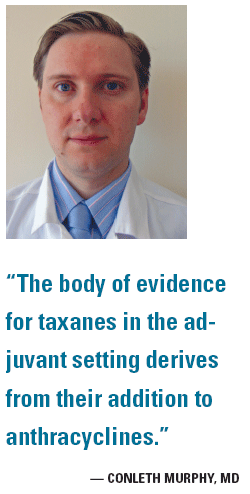Move to abandon anthracyclines in adjuvant breast cancer care is premature
Anthracyclines have occupied a prominent position in the adjuvant systemic treatment of early breast cancer for decades. Th is position was supported by the evidence from the latest overview of the Early Breast Cancer Trialists’ Collaborative Group (EBCTCG) showing an absolute survival benefit of about 4% at 10 years for anthracycline-containing regimens versus CMF-like regimens.
Anthracyclines have occupied a prominent position in the adjuvant systemic treatment of early breast cancer for decades. Th is position was supported by the evidence from the latest overview of the Early Breast Cancer Trialists’ Collaborative Group (EBCTCG) showing an absolute survival benefit of about 4% at 10 years for anthracycline-containing regimens versus CMF-like regimens.

Recently, however, the place of the anthracyclines as a pre-eminent component of adjuvant chemotherapy regimens has been challenged from several angles (see “Do anthracyclines still have a role as adjuvant treatment of breast cancer?,” August 2008, page 2).
In the face of 30 years of experience with anthracyclines in the adjuvant treatment of breast cancer (see Sidebar) and subsequent extensive phase III experience exploring the addition of taxanes to anthracyclines, is it really appropriate to abandon their use? With one notable exception-patients at particularly high risk for anthracycline-induced cardiomyopathy- we think not.
The issue at stake Here’s a clinical scenario: Ms. Jane Doe is sitting across the desk from you. She is a healthy woman in her early 40s, recently diagnosed with an early breast cancer-let’s say she’s ER-positive and HER2-negative with five positive lymph nodes. As per the Adjuvant! model, she has a 62.6% chance of dying from her breast cancer over the next 10 years, and AC-Taxane-type chemotherapy will lead to a 20.4% improvement in survival in this setting.
Clinicians here at Memorial Sloan- Kettering Cancer Center (MSKCC), and across the country face every day the question, Is it appropriate to consider omitting anthracycline chemotherapy in this patient based on current information? The resounding answer at our practice is no.
Anthracyclines will continue to play a vital role in adjuvant treatment and not just for women who fi t the clinical scenario described in our vignette. The evidence just isn’t out there to justify abandoning a cornerstone of therapy and potentially compromising cure.
HER2-negative patients Much of the recent argument against anthracyclines derives from data suggesting that their benefit is limited to patients with HER2-positive tumors and/or topoisomerase IIa amplification. These data are by no means definitive, however.

A British analysis published online this month is at variance to this perceived wisdom. In this trial, no effect of topoisomerase IIa on anthracycline sensitivity was demonstrated, and “normal,” rather than aberrant, expression of HER-family receptors appeared to predict for benefi t from anthracycline use.
Clearly, our understanding of this complex molecular choreography is still at an early stage, and we consider it too soon to advise drastic changes of practice based on preliminary (and confl icting) data.
HER2-positive patients Some would have us conclude that the application of trastuzumab (Herceptin) may abrogate the usefulness of anthracycline in the HER2-positive population. Aft er all, isn’t that what we are striving for-the replacement of older, more toxic agents with newer, less toxic ones? But the supposition that anthracyclines are not valuable in this setting is not supported by the data.
The arguments against anthracyclines in the HER2-positive population arise from the BCIRG 006 trial, which showed no difference in efficacy outcomes between the trastuzumab arms with or without anthracycline. Th is as yet unpublished trial also showed that AC-T is equivalent to Taxotere (docetaxel), carboplatin, and Herceptin (TCH) in patients whose tumors co-amplify the Topo IIa gene with HER2.
Notably, the HERA trial showed a similar benefi t from trastuzumab in patients who had received anthracyclines as in those who had not. It appears that the benefi ts of trastuzumab and anthracyclines in HER2 positives are not overlapping, interchangeable eff ects. Most evidence in support of trastuzumab in the adjuvant setting comes from its use in anthracycline-containing regimens. It would seem imprudent, even rash, to abandon the use of anthracyclines in the HER2-positive population on the basis of a single trial. Currently, our inclination is to adhere to the bulk of evidence and include anthracyclines in trastuzumab patients unless clearly contraindicated.
Substitutions for anthracyclines?
Here is the big question: Do taxanes replace anthracyclines, or do they add to them? The major trial that purports to answer this question is the US Oncology trial of AC vs TC (docetaxel-cyclophosphamide) which shows superior outcomes with TC.
Our concern here is that the control arm (four cycles of AC) is not a current relevant standard regimen used in our center, or, indeed, in the community at large. Most oncologists would employ an anthracycline- and-taxane-containing regimen, particularly in node-positive or high-risk node-negative disease.
If TC really is superior to AC, then whom does this conclusion affect? Some would argue that there is a group of patients who can do without AC-taxane. In defense of this position, a recent subset analysis is often cited that suggested that paclitaxel added nothing in patients with HER2-negative, ER-positive breast cancer (over 50% of patients in this trial).
We don’t think this single analysis warrants a change of our established practice, particularly when there is evidence that contradicts this finding: a meta-analysis examining available trials with data on the relationship between HER2 status and taxane efficacy in the adjuvant setting showing evidence for taxane benefit in both HER2-positive and -negative patients.
The overwhelming body of evidence for taxanes in the adjuvant setting derives from their addition to, rather than substitution for, anthracyclines. Indeed, a meta-analysis of more than 22,000 patients revealed an absolute 5- year risk reduction of 5% for DFS and 3% for OS with the addition of taxanes to anthracycline regimens.
A review of the literature reveals no other adjuvant trials comparing adjuvant anthracycline regimens to taxanebased, nonanthracycline regimens other than the “AC vs TC” trial. Is it simply a curiosity that the addition of docetaxel to doxorubicin (“AT”) was not superior to AC in the North American Breast Cancer Intergroup E2197 adjuvant trial involving 2,882 patients, as recently reported?
It would seem to follow that the existence of docetaxel does not herald the death of anthracycline.
There is a paucity of data available comparing anthracycline to nonanthracycline regimens in the adjuvant setting. There is somewhat more clarity in the metastatic setting, with a recent meta-analysis showing inferior progression- free survival (PFS), but not response rate or overall survival with single-agent taxanes, as compared with anthracyclines in the first-line setting. Clearly, it would be optimal to have the molecular tools to select and tailor adjuvant therapy, beyond ER, PR, and HER2. We’re just not there yet.
References:
Click here (PDF) for references
Gedatolisib Combo With/Without Palbociclib May Be New SOC in PIK3CA Wild-Type Breast Cancer
December 21st 2025“VIKTORIA-1 is the first study to demonstrate a statistically significant and clinically meaningful improvement in PFS with PAM inhibition in patients with PIK3CA wild-type disease, all of whom received prior CDK4/6 inhibition,” said Barbara Pistilli, MD.